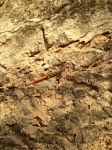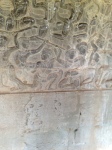Angkor Wat, located in Siem Reap Province in Cambodia, is the world’s largest religious monument. “Angkor” comes from Sanskrit and means “city” while Wat is Khmer for “temple.” Cambodians are usually referred to as Khmer people and Thai are referred to as Siem. So, the name Siem Reap means “Thai Defeat,” but that’s another story. Angkor Wat also appears on the national flag of Cambodia.
Angkor Wat was originally built in the 12th century by king Suryavarman II as a Hindu temple. It was a dedication to Vishnu. Later, in the 16th century, Buddhism took over and Angkor Wat was converted to a Buddhist temple. The Buddhists tried to paint the giant wall mural depicting several scenes from Hinduism and in some parts, you can actually touch the carved stone on the mural.
Angkor Wat lies on an island 1km x 1.5km with a 1 km wide moat on all sides. There are two entrances: the front in the west and the back in the east. Angkor Wat, unlike most temples, faces to the west instead of the east to signify that Suryavarman was intending to be buried there. Inside the temple, there is a central point where you can see in all four directions, many intricate and sometimes unfinished carvings, and a big central tower which was the king’s tomb. The central has really steep stairs that you could be afraid of going up and down.
Overall, Angkor Wat is a great place and has a lot of extra history and details to it, and it is also a great tourist destination.








